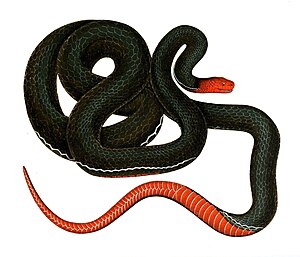Calliophis bivirgata
| Calliophis bivirgata | ||||||||||||
|---|---|---|---|---|---|---|---|---|---|---|---|---|

Calliophis bivirgata |
||||||||||||
| Systematics | ||||||||||||
|
||||||||||||
| Scientific name | ||||||||||||
| Calliophis bivirgata | ||||||||||||
| ( Boie , 1827) |
The blue abdominal viper ( Calliophis bivirgata , syn .: Maticora bivirgatus ) is a poisonous species of snake from the Elapidae family . It is also known as the blue coral snake . The distribution area is in Southeast Asia .
Occurrence and distribution
The snake lives ground-dwelling in Brunei , Indonesia , Malaysia , Singapore , Thailand , and Burma . You can find them at sea heights of 100 to 1100 meters.
There are three subspecies:
- C. b. bivirgata - Indonesia
- C. b. flaviceps - Indonesia, Malaysia, Thailand, Singapore, Burma
- C. b. tetrataenia - Indonesia, Malaysia, Brunei
description
The blue abdominal viper was originally included in the genus Maticora until phylogenetic studies revealed that the snake actually belongs to Calliophis .
It is a medium-sized coral snake with a slim build. Adult animals reach a length of about 1.8 meters. The head is red, as is the tail and underside. The back is dark blue to black in color and usually shows a large blue or white stripe on the flanks.
Frequently the Blue stomach glands with Otter is Schlegel Ried Natter ( Calamaria schlegeli ) or Rotkopfkrait confused because the distribution areas and the outside of same. The reed snake, however, is smaller (up to about 50 cm in length) and non-toxic, whereas the red-headed krait does not have a red underside.
behavior
The blue abdominal viper is rarely encountered and shows a partially burrowing behavior, it likes to stay under dead foliage in forests. Other snakes, such as cobras , are also possible prey . When threatened, it usually flees or takes a defensive position with its red tail pointed.
Toxicity
The strong poison has occasionally led to human deaths in the past. In addition, the venom glands are unusually long and extend up to a quarter of the length of the body.
Unlike the other snakes of the Elapidae family, the venom does not contain any neurotoxin . Instead, it is a cell toxin that can destroy muscle tissue. Phosphodiesterases promote the release of adenosine , which leads to hypotension , and inflammation and neurotransmitter blockages also occur in the bitten animals. The neurons' sodium channels can no longer close and convulsions occur, rendering the prey incapable of action.
literature
- Boie F . 1827. " Remarks on Merrem's attempt at a system of amphibians. 1st delivery: Ophidier ". Isis of Oken 20: 508-566. ( Elaps bivirgatus , p. 556).
- Boulenger GA . 1896. Catalog of the Snakes in the British Museum (Natural History). Volume III., Containing the Colubridæ (Opisthoglyphæ and Proteroglyphæ), ... London: Trustees of the British Museum (Natural History). (Taylor and FRancis, printers). xiv + 727 pp. + Plates I-XXV. ( Doliophis bivirgatus , pp. 400-401).
- The I . 2006. A Photographic Guide to Snakes and Other Reptiles of Borneo . Sanibel Island, Florida: Ralph Curtis Books. 144 pp. ISBN 0-88359-061-1 . ( Calliophis bivirgata [sic], p. 61).
- Oshea, Mark ; Halliday, Tim; Metcalf, Jonathan (editor). 2002. Reptiles and Amphibians: Smithsonian Handbooks . London: DK (Dorling Kinderley). 256 pp. ISBN 9780789493934 .
Individual evidence
- ↑ a b c d Calliophis bivirgatus . Ecologyasia. 2016.
- ↑ a b c d Calliophis bivirgatus in The Reptile Database ; accessed on December 30, 2016.
- ↑ JB Slowinski, J. Boundy and R. Lawson. 2001. The phylogenetic relationships of Asian coral snakes (Elapidae: Calliophis and Maticora ) based on morphological and molecular characters. Herpetologica 57 (2) 233-245
- ↑ Coral snakes: colors, bites, farts, and facts. Live science. December 16, 2014.
- ↑ a b c d Tan, CH, et al. (2015). Unveiling the elusive and exotic: Venomics of the Malayan blue coral snake ( Calliophis bivirgata flaviceps ). Journal of Proteomics 132, 1.
- ↑ Toxicology: This snake is unique in killing . ( Spektrum.de [accessed on December 29, 2016]).